
Dynamics

|
Generational Dynamics |
| Forecasting America's Destiny ... and the World's | |
| HOME WEB LOG COUNTRY WIKI COMMENT FORUM DOWNLOADS ABOUT | |
As I've said many times on this web site, the stock market today is overvalued by a factor of about 250% (about the same as in 1929). I've discussed various methods for evaluating the "real value" of the stock throughout this web site, but it's been a long time since I put everything together. This article does that.
|
In addition, as it now appears that we'll be having a stock market crash in a matter of weeks, we'll try to refine the speculative estimates of when that might occur.
We've previously discussed three methods for evaluating the stock market. We'll summarize them here.
Understanding deflation: Why there's less money in the world today than a month ago.:
As the markets continue to fall, the Fed is increasingly in a big bind....
(10-Sep-07)
Alan Greenspan predicts the panic and crash of 2007:
He's said this kind of thing before, but this time it's resonating....
(08-Sep-07)
Bernanke's historic experiment takes center stage:
An assessment of where we are and where we're going....
(27-Aug-07)
How to compute the "real value" of the stock market. :
And some additional speculations about stock market crashes.
(20-Aug-2007)
Ben Bernanke's Great Historic Experiment:
Bernanke doesn't believe that bubbles exist. His Fed policy will now test his core beliefs....
(18-Aug-07)
Redemptions of money market funds now fully in doubt:
Wednesday is the deadline for 3Q redemption of many hedge fund shares....
(15-Aug-07)
Alan Greenspan defends his Fed policies, as people blame him for the subprime crisis:
Greenspan never ceases to amaze, and he did so again on Monday....
(8-Aug-07)
Nouriel Roubini says: "Worry about systemic risk." Whoo hoo!:
His arguments show what's wrong with mainstream macroeconomics....
(6-Aug-07)
Robert Shiller compares stock market to 1929:
He says the recent fall was caused by "market psychology," but is puzzled why....
(20-Mar-07)
A conundrum: How increases in 'risk aversion' lead to higher stock prices:
Maybe because the global financial markets are increasingly "accident-prone."...
(12-Mar-07)
Pundits are suddenly talking about (gasp!) "risk aversion":
Fearing full-scale panic in the mortgage loan marketplace,...
(6-Mar-07)
Alan Greenspan blames the housing bubble on the fall of the Berlin Wall:
Meanwhile, the stock market keeps skyrocketing and appears unstoppable to many investors....
(25-Oct-06)
System Dynamics and the Failure of Macroeconomics Theory :
Mainstream macroeconomic theory, invented by Maynard Keynes in the 1930s, has failed to predict or explain anything that's happened since the bubble started, including the bubble itself. We need a new "Dynamic Macroeconomics" theory.
(25-Oct-2006)
Alan Greenspan gives another harsh doom and gloom speech:
Saying that "the consequences for the U.S. economy of doing nothing could be severe,"...
(4-Dec-05)
Ben S. Bernanke: The man without agony :
Bernanke and Greenspan are as different as night and day, despite what the pundits say.
(29-Oct-2005)
Fed Chairman Alan Greenspan says that the deficit is out of control:
France's Finance Minister Thierry Breton quoted Greenspan...
(25-Sep-05)
Fed Governor Ben Bernanke blames America's sky-high public debt on other nations:
I'm normally wary of applying specific generational archetypes to individuals, but Bernanke is acting like a Baby Boomer....
(14-Mar-05)
Greenspan's testimony further repudiates his earlier stock bubble reasoning:
The Fed Chairman has now completely reversed his previous position on the stock market bubble...
(17-Feb-05)
Alan Greenspan warns that global economic dangers are without historical precedent :
In a speech on Friday, Greenspan buried a major change of position in a speech admitting that his assumptions about the economy for the last decade were wrong.
(6-Feb-2005)
| ||
The following graph shows the S&P 500 Price/Earnings index for 1871-2007. For each company, it takes the stock price and divides by the company's earnings for the previous year per share of stock. The term "P/E1" means "price divided by previous year's earnings."
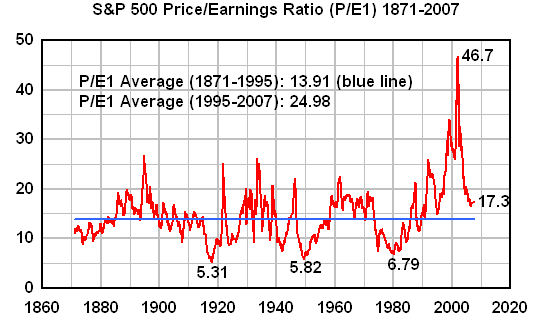 |
Informally, you can think of the P/E ratio as the number of years it will take to get your investment back. This isn't precise, but it's based on the following reasoning: Suppose that the P/E ratio is 20. That means that if you pay $100 per share, then the company earns $5 per share each year. Theoretically those earnings will be returned to you in the form of either a higher stock price or dividend payout. So theoretically you'll make $5 per year one way or the other, and you'll get your $100 back in 20 years.
Another way of looking at it is as the reciprocal of the interest rate. If you pay $100 for a share of stock, and you get back $5 per year, then you're earning 5% interest per year, and 1/20 = 5%.
Historically, the P/E ratio averages around 14 (which corresponds to about 7% interest), as you can see from the above graph. Pundits often use the word "valuations" as a synonym for price/earnings ratios.
Historically, P/E ratios have been considered a very important indicator of the value of a share of stock. But in the last ten years, journalists, pundits and analysts have taken to out and out lying about P/E ratios. Why? Because P/E ratios have been way above average since the dot-com bubble began in 1995, as you can see from the above graph.
Here are some of the out and out lies that I've heard on TV and seen in print:
The way they get this is as follows: They take today's stock price, and they divide it by the company's estimates of NEXT YEAR's earnings. That gives the earnings a nice boost of 10-20%, which gives a phony P/E ratio figure.
No, valuations today are around 17, which is above average.
Here the big problem is ignoring the Law of Mean Reversion.
This means the following: 14 is AVERAGE, not the MINIMUM. If the P/E ratio has been mostly WELL ABOVE average since 1995, then it has to be mostly WELL BELOW average from now on, so that the average for the entire period is 14.
This is the "it's different this time" excuse that people use prior to the bursting of every bubble in history.
If you look at the above graph, you can easily see that the P/E ratio has been above average (the blue line) since 1995, and has been as low as 6 several times in the last century, most recently at 6.79 in 1980.
Now, if it's fallen to around 6 several times in the past (5.31, 5.82 and 6.79), then it's going to fall below 6 again. There's no doubt it, except in the fantasies of people living in denial.
If you look at the right hand side of the graph, you can see that it appears to be about to fall to that level right now, or in the very near future.
What will the value of the stock market be when the P/E ratio falls to 6 again?
Well, the ratio is around 17 today, so a fall to 6 would bring stock prices down by a factor of 6/17, assuming earnings stay the same. So if the market is at Dow 13079 today, then it will fall to Dow 13079*(6/17) = 4616. If we assume that earnings will fall, rather than staying the same, then the market will fall even lower.
Actually, a fall in earnings is to be expected, so the market should fall to well below Dow 4616, at least for a while until earnings are restored.
Before going on to the next method, let me call the reader's attention to the graph on the bottom of the bottom of the home page of this web site, there's a graph that changes weekly showing the S&P 500 price/earnings index for the last ten years. Here's the chart as of August 17:
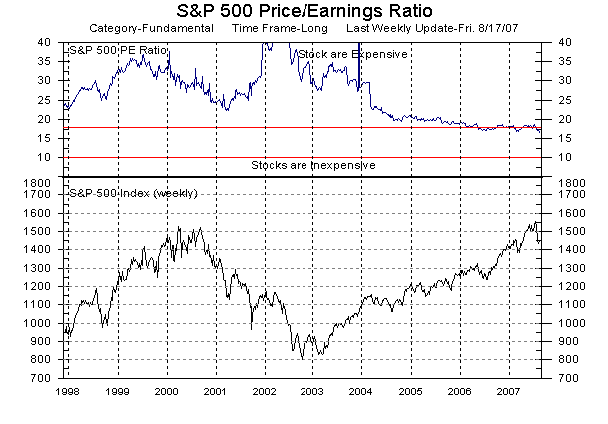 |
The top part of this graph shows the S&P 500 Price/Earnings ratio. Notice that the graph has been in the "stocks are expensive" region since 1995 until recently. By the Law of Mean Reversion, it will be necessary for stocks to become "inexpensive" for a similar length of time. (The last two paragraphs were added on August 22.)
Over long periods of time, many quantities in nature grow exponentially. This is true of such things as population variables, many technology variables, and many financial variables. It's true of the "real value" of a collection of companies, and therefore it's true of stock prices, which are supposed to represent the "real value" of these companies.
Therefore, we can take a graph of stock prices and do "exponential curve fitting," to get the best-fit exponential curve that matches the stock prices.
Here's the graph for the Dow Jones Industrial Average since 1900:
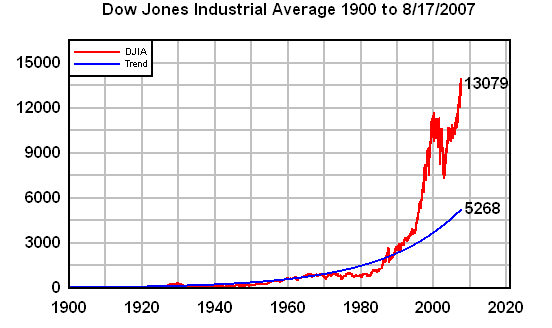 |
The red curve is the actual stock index, and the blue curve is the best-fit exponential growth curve.
The above graph is hard to read because prices have been so high since 1995 that points on the graph prior to 1940 are hard to distinguish.
So here's the same graph, but restricted to the years 1900-1940:
 |
If you want to be able to read the entire graph, from 1900 to the present, the best way is to view it with a logarithmic Y-axis:
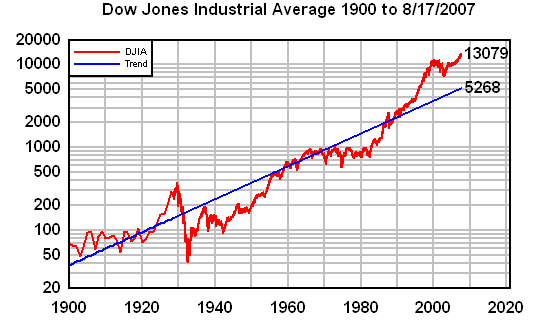 |
On this graph, the exponential curve becomes a straight line, and you can easily read values off the graph for all years.
The blue line is the "real value" of the companies represented, and it's determined by exponential curve fitting to the stock price, which assumes that, over the long run, the stock price represents the "real value" of the companies.
So you can see that on Friday, August 17, the Dow was at 13079, but the "real value" of the market was at 5268. This is not so far from the value 4616 that we got from Method #1, examining P/E ratios.
Understanding deflation: Why there's less money in the world today than a month ago.:
As the markets continue to fall, the Fed is increasingly in a big bind....
(10-Sep-07)
Alan Greenspan predicts the panic and crash of 2007:
He's said this kind of thing before, but this time it's resonating....
(08-Sep-07)
Bernanke's historic experiment takes center stage:
An assessment of where we are and where we're going....
(27-Aug-07)
How to compute the "real value" of the stock market. :
And some additional speculations about stock market crashes.
(20-Aug-2007)
Ben Bernanke's Great Historic Experiment:
Bernanke doesn't believe that bubbles exist. His Fed policy will now test his core beliefs....
(18-Aug-07)
Redemptions of money market funds now fully in doubt:
Wednesday is the deadline for 3Q redemption of many hedge fund shares....
(15-Aug-07)
Alan Greenspan defends his Fed policies, as people blame him for the subprime crisis:
Greenspan never ceases to amaze, and he did so again on Monday....
(8-Aug-07)
Nouriel Roubini says: "Worry about systemic risk." Whoo hoo!:
His arguments show what's wrong with mainstream macroeconomics....
(6-Aug-07)
Robert Shiller compares stock market to 1929:
He says the recent fall was caused by "market psychology," but is puzzled why....
(20-Mar-07)
A conundrum: How increases in 'risk aversion' lead to higher stock prices:
Maybe because the global financial markets are increasingly "accident-prone."...
(12-Mar-07)
Pundits are suddenly talking about (gasp!) "risk aversion":
Fearing full-scale panic in the mortgage loan marketplace,...
(6-Mar-07)
Alan Greenspan blames the housing bubble on the fall of the Berlin Wall:
Meanwhile, the stock market keeps skyrocketing and appears unstoppable to many investors....
(25-Oct-06)
System Dynamics and the Failure of Macroeconomics Theory :
Mainstream macroeconomic theory, invented by Maynard Keynes in the 1930s, has failed to predict or explain anything that's happened since the bubble started, including the bubble itself. We need a new "Dynamic Macroeconomics" theory.
(25-Oct-2006)
Alan Greenspan gives another harsh doom and gloom speech:
Saying that "the consequences for the U.S. economy of doing nothing could be severe,"...
(4-Dec-05)
Ben S. Bernanke: The man without agony :
Bernanke and Greenspan are as different as night and day, despite what the pundits say.
(29-Oct-2005)
Fed Chairman Alan Greenspan says that the deficit is out of control:
France's Finance Minister Thierry Breton quoted Greenspan...
(25-Sep-05)
Fed Governor Ben Bernanke blames America's sky-high public debt on other nations:
I'm normally wary of applying specific generational archetypes to individuals, but Bernanke is acting like a Baby Boomer....
(14-Mar-05)
Greenspan's testimony further repudiates his earlier stock bubble reasoning:
The Fed Chairman has now completely reversed his previous position on the stock market bubble...
(17-Feb-05)
Alan Greenspan warns that global economic dangers are without historical precedent :
In a speech on Friday, Greenspan buried a major change of position in a speech admitting that his assumptions about the economy for the last decade were wrong.
(6-Feb-2005)
| ||
But there's more: Remember from Method #1 that we said that the market should be expected to fall well below 4616 for a while. Well, we reach the same conclusion with Method #2.
In the case of exponential growth, we have a Law of Trend Reversion which is similar to the Law of Mean Reversion: If stock values have been well above the trend line for the last 12 years, then they will have to be well below the trend line for the next 12 years.
Here's another way to look at it: From 1904 to 1994, the Dow averaged 4.5% growth per year. That number, 4.5%, represents the true growth rate for these companies. But for the last 20 years, the Dow averaged 9.7% growth per year, which is about 5% per year too high.
Are the Laws of Mean Reversion and Trend Reversion real laws? Yes, they are, as real as the Law of Gravity. And just as people have tried to defeat the Law of Gravity for thousands of years, by attaching wings to their arms and flapping them, investors and Fed Chairmen today want to believe that "this time it's different," and that they've found a way to defeat these laws by setting interest rates to near-zero. They haven't defeated anything.
Actually, if you look at the graphs above, and compare what happened in 1929 versus where we are today, you see a striking difference: In 1929 the market collapsed precipitously, and kept falling for four years, until the worst was over.
But that didn't happen after the dot-com crash in 2000, as you can see from the graphs. Instead, the Fed, dropped interest rates to near-zero, thus expanding the bubble for another few years. The result is that today the bubble is much huger, and the collapse is going to be much, much uglier than the 1929 crash.
This is not my method -- the name is the title of an article that appeared in 2005 in Barron's and that I wrote about, "11% Solution - Adam Barth - Barrons."
That article makes the following points:
In fact, as of second quarter, 2007, earnings growth has indeed finally fallen down to the 4% range.
By the Law of Trend Reversion, the market will have to fall well below 4500 for a while.
So we have three methods, producing these results: Dow 4618, 5268 and 4500.
These numbers represent that approximate "real value" of the stock market today, at least for the 30 Dow Industrials stocks. However, the same computations work and produce similar results for the much broader S&P 500 stocks.
It's worth repeating the point I've made before: These methods are all quite reasonable, and the only reason that they're not considered acceptable today is because they give results that people don't want to hear.
Before every bubble bursts, people always say, "This time it's different." They were saying that last year for the housing bubble, and now look where we are.
Here's an article from Sunday's NY Times that explains how the "old timers saw this coming" a while ago, and asks why everyone else missed it.
The three methods that I've described are NOT rocket science. These methods are recognized by any person familiar with analytical forecasting. Any of these people could have predicted a coming stock market crash any time in the last five years, just as I did in 2002.
So the answer to the question, "Why did everyone else miss it?" is that they don't want to know.
From the point of view of Generational Dynamics, this kind of arrogant behavior is typical of the Baby Boomer generation, as I've discussed many times.
Make no mistake about it: The arrogant pundits and journalists and economists and financiers and bankers that you hear every day on CNBC and other stations, and read in the Wall Street Journal and other newspapers are perfectly capable of understanding what I've written here. Right now I'm so furious that I'm tempted to start naming names and say what I think of them, but I know that wouldn't be a good idea. So let me leave it this way: Many (but not all -- leaving myself an out) of the people that I've mentioned on this web site over the years have their heads up their asses.
The above discussion shows that, at any time for many years in the past, anyone could have predicted with absolutely certainty that a major stock market crash is coming. When I've talked about this in the past, I've always used words like "This could happen next week, next month, next year, or even later, but it will happen, and sooner rather than later."
And now, as I discussed a few days ago, the time has become a lot more definite: It now appears very likely that there will be a stock market crash within the next few weeks.
I have to re-emphasize that this is NOT based on stock market activity. The market has been very volatile, but that's not the reason I reached my conclusion. I reached my conclusion because of the palpable increase in the level of anxiety and panic that I'm seeing. This is exactly the kind of situation that characterizes a generational panic that can lead to a crisis war or a financial crisis.
There seems to be no doubt whatsoever that some some or tipping point was reached in the last month, probably just after the market peaked on July 19. Before then, investors reacted to bad news by pushing up the stock market to higher levels; since then, every bit of bad news only drives the market down.
So this is how you, Dear Reader, will be able to tell whether we're still headed in the direction of a stock market crash. If this pattern of increasing anxiety suddenly changes back, so that bad news drives the market up again, then the speculative prediction of a stock market crash in the next few weeks will turn out to be wrong.
All of this is completely new, untrodden territory, even within the realm of Generational Dynamics.
What we're now doing, in real time, is testing out a new theory. The theory is this: Once general investor anxiety starts to grow uncontrollably, as is happening now, then it spreads like wildfire.
Now, wildfire spreads at a particular rate of speed, and the theory is that investor anxiety is going to continue spreading at a particular rate of speed, and that the speed is irrespective of the country or time in history. In other words, all generational bubbles will have this rate of speed in common. And so, if we can estimate the speed in past generational bubbles, then we can estimate a specific date for the coming stock market crash.
In fact, based on cases I've looked at, the theory is that the wildfire spreads to a generational stock market crash in about 7-8 weeks, and burns itself out in about 4 years.
In the case of 2007, we count the panic as starting when the market peaks, which would be July 19. In 1929 the market peaked on September 3, and the generational crash began on Black Thursday, October 24. The wildfire then burned itself out in 1933. That's where we get the 7 week / 4 year figures from.
In fact, we can refine some of the information in my 2006 article, "Speculations about a stock market panic and crash"
Here's a graph of the 1929 crash:
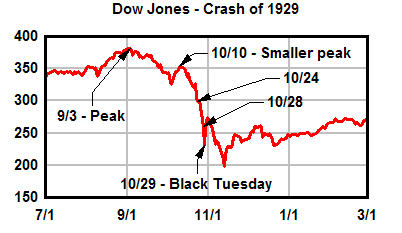 |
Notice the following pattern:
In recent web log articles, I've been posting the following comparison table, based on data from my Dow Jones historical page:
1929 % of peak (381.17)
-------------------------
Tue 09-03 ( +0.22%) 100% 2007 % of peak (14000)
Wed 09-04 ( -0.41%) 99% ------------------------
Thu 09-05 ( -2.59%) 97% Thu 07-19 ( +0.59%) 100%
Fri 09-06 ( +1.76%) 98% Fri 07-20 ( -1.07%) 98%
------------------------ ------------------------
Mon 09-09 ( -0.36%) 98% Mon 07-23 ( +0.67%) 99%
Tue 09-10 ( -2.04%) 96% Tue 07-24 ( -1.62%) 97%
Wed 09-11 ( +0.99%) 97% Wed 07-25 ( +0.50%) 98%
Thu 09-12 ( -1.23%) 96% Thu 07-26 ( -2.26%) 96%
Fri 09-13 ( +0.14%) 96% Fri 07-27 ( -1.54%) 94%
------------------------ ------------------------
Mon 09-16 ( +1.51%) 97% Mon 07-30 ( +0.70%) 95%
Tue 09-17 ( -1.04%) 96% Tue 07-31 ( -1.10%) 94%
Wed 09-18 ( +0.65%) 97% Wed 08-01 ( +1.14%) 95%
Thu 09-19 ( -0.25%) 97% Thu 08-02 ( +0.76%) 96%
Fri 09-20 ( -2.14%) 94% Fri 08-03 ( -2.09%) 94%
------------------------ ------------------------
Mon 09-23 ( -0.84%) 94% Mon 08-06 ( +2.18%) 96%
Tue 09-24 ( -1.78%) 92% Tue 08-07 ( +0.26%) 96%
Wed 09-25 ( -0.01%) 92% Wed 08-08 ( +1.14%) 97%
Thu 09-26 ( +0.96%) 93% Thu 08-09 ( -2.83%) 94%
Fri 09-27 ( -3.11%) 90% Fri 08-10 ( -0.23%) 94%
------------------------ ------------------------
Mon 09-30 ( -0.41%) 90% Mon 08-13 ( -0.02%) 94%
Tue 10-01 ( -0.26%) 89% Tue 08-14 ( -1.57%) 93%
Wed 10-02 ( +0.56%) 90% Wed 08-15 ( -1.29%) 91%
Thu 10-03 ( -4.22%) 86% Thu 08-16 ( -0.12%) 91%
Fri 10-04 ( -1.45%) 85% Fri 08-17 ( +1.82%) 93%
------------------------
Mon 10-07 ( +6.32%) 90%
Tue 10-08 ( -0.21%) 90%
Wed 10-09 ( +0.48%) 90%
Thu 10-10 ( +1.79%) 92%
Fri 10-11 ( -0.05%) 92%
------------------------
Mon 10-14 ( -0.49%) 92%
Tue 10-15 ( -1.06%) 91%
Wed 10-16 ( -3.20%) 88%
Thu 10-17 ( +1.70%) 89%
Fri 10-18 ( -2.51%) 87%
------------------ -----
Mon 10-21 ( -3.71%) 84%
Tue 10-22 ( +1.75%) 85%
Wed 10-23 ( -6.33%) 80%
Thu 10-24 ( -2.09%) 78% Black Thursday
Fri 10-25 ( +0.58%) 79%
------------------------
Mon 10-28 (-13.47%) 68% Black Monday
Tue 10-29 (-11.73%) 60%
Wed 10-30 (+12.34%) 67%
Thu 10-31 ( +5.82%) 71%
Fri 11-01 (Closed)
-----------------------
Mon 11-04 ( -5.79%) 67%
Tue 11-05 (Closed)
Wed 11-06 ( -9.92%) 60%
Thu 11-07 ( +2.61%) 62%
Fri 11-08 ( -0.70%) 62%
------------------------
Mon 11-11 ( -6.82%) 57%
Tue 11-12 ( -4.83%) 55%
Wed 11-13 ( -5.27%) 52%
Thu 11-14 ( +9.36%) 57%
Fri 11-15 ( +5.27%) 60%
-----------------
The above table provides a convenient way of comparing the 1929 event with today, to see if they continue to match up.
|
Now let's look at another example, the crash of the Tokyo Stock Exchange (TSE) in 1990.
The comparison to Japan in the 1990s is very useful, since that was a generational panic and crash as well, just like 1929 and what we're facing today. The previous major stock market crash at the Tokyo Stock Exchange (TSE) was in 1919.
So you have: Wall Street: Crash in 1929, new bubble in 1995, 66 years later; Tokyo Stock Exchange: Crash in 1919, new bubble in 1984, 65 years later. (See my February article "Japan's real estate crash may finally end after 16 years.")
Here are some graphs from the February article showing the Nikkei 225 index:
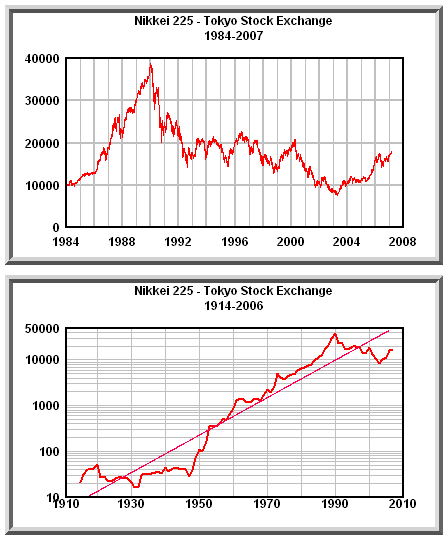 |
The first chart shows that the crash began on January 4, 1990, and burned itself out about three years later. The second chart shows that the same thing was true for the 1919 crash.
Now here's a chart that gives more detail on the TSE 1990 crash:
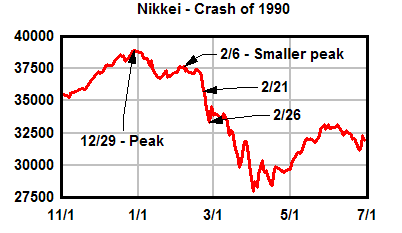 |
The peak was reached on 12/29, there was a smaller peak 5 weeks later, and the crash began on 2/21, about 7 weeks later. So this supports a 5 week and 7-8 week theory.
A web site reader wrote to me this morning to tell me he's done a little research on the 1720 South Sea Bubble. The stock peaked at 1000 on Aug 1, and crashed to 700 around September 1. By October 1, it was at 135.
This is a faster rate than we're talking about, but there isn't enough information, because that's only one stock, and we're looking for a reading on the entire stock market. Still, if one stock crashed in four weeks, then it's reasonable to think that the entire stock market crashed in 7-8 weeks. That needs more research, of course.
And so, as I said, this is a theory that we're testing out in real time. Here's the schedule that this speculative theory is predicting:
Let me say again, this is not a prediction; we're testing a theory in real time.
How will we know whether the theory is on track or not? There are two ways:
I received a call from another web site reader today. He's 64 years old, and he's been doing exactly this kind of analysis for years. He says that there's another correlation that can be made:
The person feels strongly that these two events are highly correlated. I haven't checked out this "Peak minus 5 months" theory with any other panics, but it's worth checking out.
However, all of this got me to thinking. Maybe the "level of investor anxiety and panic" didn't start increasing on February 27. Maybe it's one more exponential growth variable, and if we could only find the right way to measure it numerically, then we could plot it. It would start out very slowly, maybe 2, 3, 4, 5 or even 10 years ago, with the LTCM event. The exponential growth would be hardly noticeable, because it starts with a base of near-zero. However, it keeps growing exponentially until a crash occurs.
One thing is for certain: Some sort of major "tipping point" was reached shortly after the July 19 stock market peak.
I'm imagining some kind of graph with two curves. One shows the arrogance of the Boomer generation, starting from their birth (1943-1960) and growing exponentially, slowly but surely. Their arrogance creates the dot-com bubble, the housing bubble, the credit bubble, the CDOs, etc.
The second curve is the "anxiety and panic" curve. It starts much later -- around the mid-1990s -- but it grows at a faster exponential rate. The second curve caught up to the first one, and the two curves cross on this imaginary graph, on July 19 of this year. That crossover point is the tipping point. Seven or eight weeks later, according to this speculative theory, a stock market crash occurs.
The last question is this: When will the stock market crash end? The 1929 crash didn't end until 1933, and we're speculating that it always ends around 4 years after it begins. That would mean that it would end in 2011.
There's actually another way to get at the 2011 figure. Let's take another look at the Price/Earnings graph posted near the beginning of this article:
 |
Notice that the three points that I labeled as lows (5.31, 5.82 and 6.79) occurred at 31-year intervals. (But there's nothing like that in 1887, so this may be completely wrong.) There wasn't even a low 1932, the worst part of the 1929 crash.
So we have to consider the possibility that there's some kind of as-yet not understood 31-year cycle in price-earnings ratios. With only three data points, it's hard to be anywhere near certain. However, if the 31-year cycle holds, then the next low will be in 2011.
For me, this is all incredibly exciting stuff. I just wish that there weren't so much at stake, for me, my country and the world. No wonder I'm totally obsessed with Generational Dynamics research -- I experience overwhelming fascination one minute and overwhelming dread and depression the next minute. I guess that must be what obsession is all about.